Giochi dell'Oca e di percorso
(by Luigi Ciompi & Adrian Seville)
(by Luigi Ciompi & Adrian Seville)

|
Giochi dell'Oca e di percorso
(by Luigi Ciompi & Adrian Seville) |

|
 |

Torna alla ricerca giochi (back to game search) |
 |
| Jeu (Le) Royal de Cupidon, autrement appellé le passe-temps d'Amour | ||
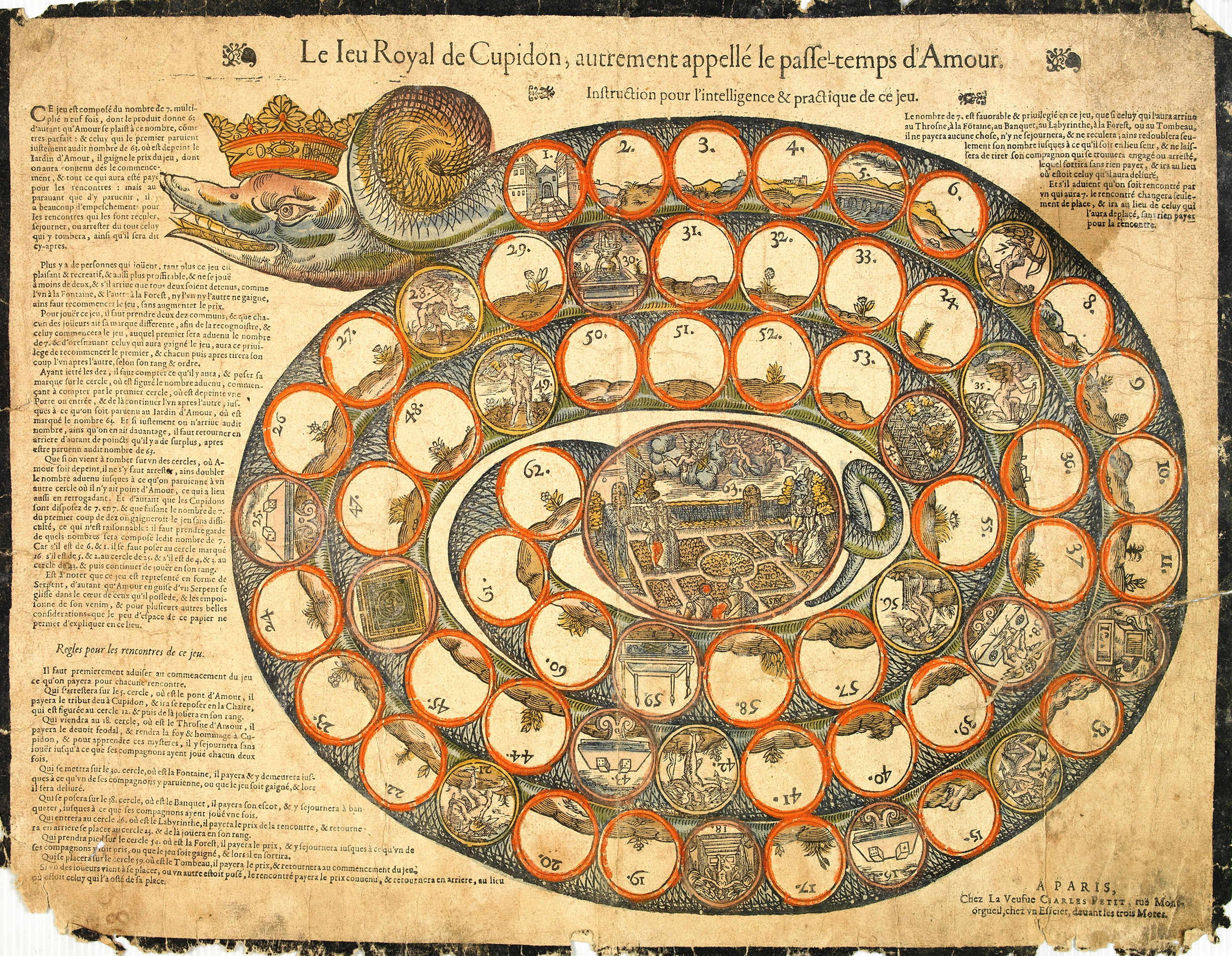 |
Versione stampabile
 |
Invia una segnalazione

|
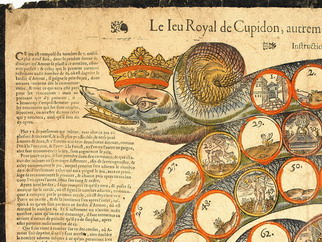 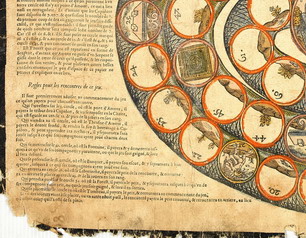 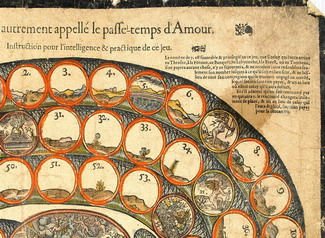 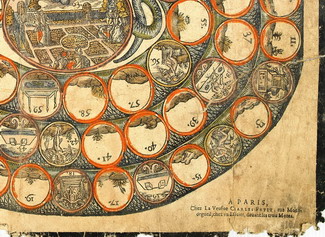 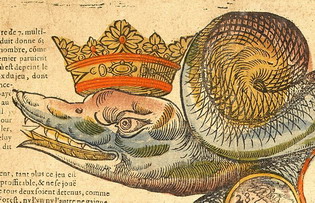 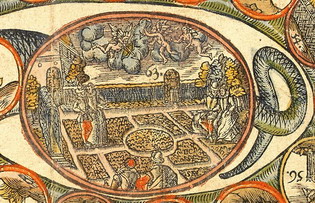 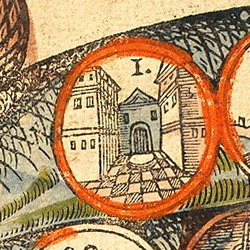 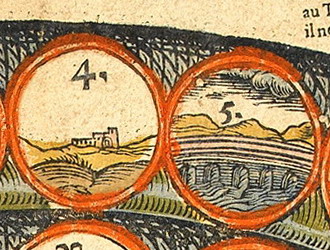 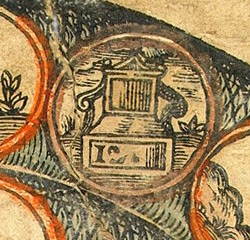 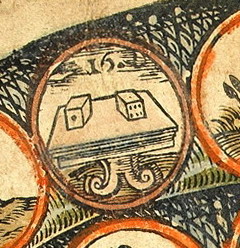 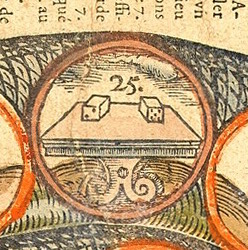 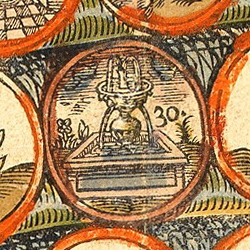 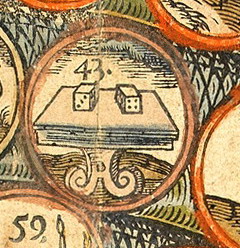 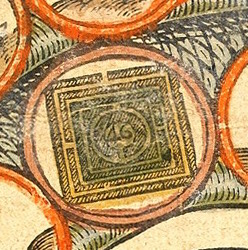 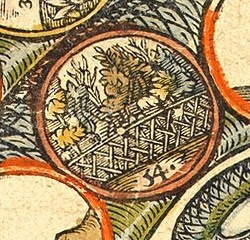 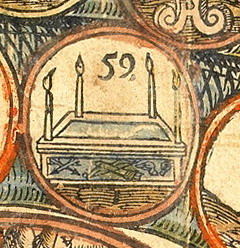  |
primo autore: | Anonimo |
| secondo autore: | Veuve Petit | |
| anno: | 1640ca | |
| luogo: |
Francia-Parigi |
|
| periodo: | XVII secolo (2°/4) | |
| percorso: | Percorso di 63 caselle numerate | |
| materiale: | carta incollata su cartone (paper) (papier) | |
| dimensioni: | 400X520 | |
| stampa: | Stampa su legno (bois gravé) (woodcut) | |
| luogo acquisto: | ||
| data acquisto: | ||
| dimensioni confezione: | ||
| numero caselle: | 63 | |
| categoria: | Amore, matrimonio e famiglia | |
| tipo di gioco: | Gioco di percorso | |
| editore: | A Paris Chez la Veusve Charles Petit Rue Montorgueil, chez un Espicier devant les trois Mores | |
| stampatore: | A Paris Chez la Veusve Charles Petit Rue Montorgueil, chez un Espicier devant les trois Mores | |
| proprietario: | Collezione A. Seville | |
| autore delle foto: | A. Seville | |
| numero di catalogo: | 1240 | |
| descrizione: |
Gioco di 63 caselle numerate, spirale, orario, centripeto che ha la forma di un serpente. Questo gioco anticipa per grafica un gioco della metà del XVIII secolo realizzato da Robert Sayer, mercante di carte e di stampe a cui successero nel 1794 Robert Laurie&James Whittle e nel 1813 Richard H. Laurie. L'antico gioco egiziano del serpente, di forma spirale, può aver ispirato molti giochi di società, ma le regole rimangono ancora sconosciute. Nel Gioco del Serpente alla casella 63 si può osservare: - tre coppie di amanti con Cupidi fra le nuvole (De Jode Pieter 1620ca / Veuve Petit 1640ca); - Cupido che affila la punta della sua freccia in un giardino (Laurie&Whittle, 1794 / Lumsden, 1810-1830ca / R. H. Laurie,1850ca); - una coppia contadina che balla accompagnata da un Cupido che suona uno strumento (Visscher, 1625ca / Garrett, 1690ca / Dicey, 1736-40); - un Cupido da solo con il suo arco (Carington Bowles 1756 / Bowles&Carver 1763-1780ca); - due personaggi che giocano a tavola in presenza di un Cupido (Anonimo XVIII° secolo). In questo esemplare al centro si notano tre coppie di amanti con Cupidi fra le nuvole. Non esiste una versione italiana di questo gioco ad esclusione de "Il Novo et Piacevol Gioco del Giardin d’Amore (Arch. n°1105) che a parità di tema si gioca però come il gioco della civetta. In basso a destra:"A Paris Chez la Veuf(s)ve Charles Petit Rue Montorgueil, chez v(u)n Eficier deu(v)ant les trois Mores." REGOLE: nel tavoliere ai lati. "LE IEU ROYAL DE CUPIDON AUTREMENT APPELLE' LE PAFF(SS)E-TEMPS D'AMOUR INF(S)TRUCTION POUR L'INTELLIGENCE & PRATIQUE DE CE JEU "Ce jeu est composé du nombre de 7. multiplié neuf fois, dont le produit donne 63. d'autant qu'Amour f(s)e plaif(s)t à ce nombre come tres parfait: & celuy que le premier paru(v)ient iuf(s)tement audit nombre de 63 où ef(s)t depeint le Iardin d'Amour, il gagne le prix du jeu, dont on aura cou(n)venu dès le commencement, & tout ce qui aura ef(s)té payé pour les rencontres: mais ou parau(v)ant que d'y paru(v)enir, il a beaucoup d'empef(s)chements pour les rencontres qui les font reculer, f(s)ejourner ou arref(s)ter du tout celuy qui y tombera, ainf(s)i qu'il f(s)era dit cy-apres. Plus il y a de perf(s)onnes qui jouent, tant plus ce jeu ef(s)t plaif(s)ant & reacreatif, et auff(ss)i plus proffitable, & ne se joue a moins de deux, & s'il arriu(v)e que tous deux f(s)oient detenus, l'v(u)n à la Fontaine & l'autre à la Foref(s)t, ny l'un ny l'autre ne gaigne, ains faut recommencer le jeu, f(s)ans augmenter le prix. Pour jouer ce jeu, il faut prendre deux dez communs, & que chacun des joueurs ait f(s)a marque differente, afin de la recognoif(s)tre, & celuy commencera le jeu auquel premier f(s)era adu(v)enu le nombre & d'oref(s)nau(v)ant celui qui aura gaigné le jeu, aura ce priu(v)ilege de recommencer le premier, & chacun puis apres tirera f(s)on coup l'v(u)n apres l'autre f(s)elon f(s)on rang & ordre. Ayant ietté les dez, il faut compter ce qu'il y aura, & pof(s)er f(s)a marque f(s)ur le cercle, où ef(s)t figuré le nombre adu(v)enu commençant à compter par le premier cercle, où ef(s)t depeinte v(u)ne Porte ou entrée, & de là continuer l'v(u)n apres l'autre, juf(s)ques à ce qu'on f(s)oit paru(v)enu au Iardin d'Amour, où ef(s)t marqué le nombre 63. Et f(s)i iuf(s)tement on n'arriu(v)e audit nombre ains qu'on en ait dau(v)antage, il faut retourner en arriere d'autant de points qu'il y a de f(s)urplus apres ef(s)tre paru(v)enu audit nombre de 63. Que f(s)i on vient à tomber f(s)ur v(u)n des cercles, où Amour f(s)oit depeint il ne s'y faut arref(s)ter, ains doubler le nombre adu(v)enu iuf(s)ques à ce qu'on paru(v)ienne à v(u)n autre cercle où il n'y ait point d'Amour ce qui a lieu aussi en retrogradant. Et d'autant que les Cupidons f(s)ont dif(s)pof(s)ez de 7. en 7. & que faif(s)ant le nombre de 7. du premier coup de dez on gaignerait le jeu f(s)ans difficulté, ce qui n'ef(s)t raif(s)onnable: il faut prendre garde de quels nombres f(s)era compof(s)é ledit nombre de 7. Car s'il ef(s)t de 6.&1. il f(s)e faut pof(s)er au cercle marqué 16. s'il ef(s)t de 5.&2. au cercle de 25. & s'il ef(s)t de 4.&3. au cercle de 43. & puis continuer de jouer en f(s)on rang. Ef(s)t à noter que ce jeu ef(s)t repref(s)enté en forme de Serpent, d'autant que Amour en guif(s)e d'v(u)n Serpent f(s)e gliff(ss)e dans le coeur de ceux qu'il poff(ss)ede, & les empoisonne de son venim, & pour pluf(s)ieurs autres belles conf(s)iderations que le peu d'ef(s)pace de ce papier ne permet d'expliquer en ce lieu. REGLES POUR LES RENCONTRES DE CE JEU Il faut premierement adu(v)iser au commencement du jeu ce qu'on payera pour chacune rencontre. Qui s'arref(s)tera f(s)ur le 5. cercle, où ef(s)t le pont d'Amour payera le tribut deu(v) à Cupidon, & ira se repof(s)er en la Chaire, qui ef(s)t figurée au cercle 12. & puis de là jouera en f(s)on rang. Qui viendra au 18. cercle où ef(s)t le Throf(s)ne d'Amour il payera le deu(v)oir feodal & rendra la foy & hommage à Cupidon, & pour apprendre ces myf(s)teres il y f(s)ejournera f(s)ans iouer iuf(s)qu'à ce que f(s)es compagnons ayent joué chacun deux fois. Qui se mettra f(s)ur le 30. cercle, où ef(s)t la Fontaine, il payera & y demeurera iuf(s)ques à ce qu'v(u)n de f(s)es compagnons paru(v)ienne, où que le jeu f(s)oit gaigné, & lors il f(s)era deliu(v)ré. Qui f(s)e pof(s)era f(s)ur le 38. cercle, où ef(s)t le Banquer, il payera f(s)on ef(s)cot, & y f(s)ejournera à banqueter, juf(s)ques à ce que f(s)es compagnons ayent joué v(u)ne fois. Qui entrera au cercle 46. où ef(s)t le Labyrinthe, il payera le prix de la rencontre, & retournera en arriere f(s)e placer au cercle 23. & de là jouera en f(s)on rang. Qui prendra pied f(s)ur le cercle 54. où ef(s)t la Foref(s)t, il payera le prix & y f(s)ejournera iuf(s)ques à ce qu'v(u)n de f(s)es compagnons y f(s)oit pris, ou que le jeu f(s)oit gaigné, & lors il en f(s)ortira. Qui f(s)e placera f(s)ur le cercle 59. où ef(s)t le Tombeau, il payera le prix & retournera au commencement du jeu. Si v(u)n des ioueurs vient à f(s)e placer, ou v(u)n autre ef(s)toit pof(s)é, le rencontré payera le prix cou(n)venu, & retournera en arriere, au lieu où ef(s)toit celuy qui l'a of(s)té de f(s)a place. Le nombre de 7. ef(s)t fau(v)orable & priu(v)ilegié en ce jeu, qui f(s)i celuy qui l'aura arriu(v)é au Throf(s)ne, à la Fo(n)taine, au Banquer, au Labyrinthe, à la Foref(s)t, ou au Tombeau, il ne payera aucune chof(s)e, n'y ne f(s)ejournera, & ne reculera, ains redoublera f(s)eulement f(s)on nombre iuf(s)ques à ce qu'il f(s)oit en lieu f(s)eur (?), & ne laiff(ss)era de tirer f(s)on compagnon qui f(s)e trouu(v)era engagé ou arref(s)té, lequel f(s)ortira f(s)ans rien payer, & ira au lieu où ef(s)toit celuy qu'il aura deliu(v)ré. Et s'il adu(v)ient qu'on f(s)oit rencontré par v(u)n qui aura 7. le rencontré changera f(s)eulement de place, & ira au lieu de celuy qui l'aura deplacé, f(s)ans rien payer pour le rencontre." CASELLE: mute. Cas. 1) Porta; Cas. 4) Fortezza; Cas. 5) Ponte; Cas. 7) Cupido; Cas. 12) Sedia; Cas. 14) Cupido; Cas. 16) Tavolo con dadi (6+1); Cas. 18) Cupido; Cas. 21) Cupido; Cas. 25) Tavolo con dadi (5+2); Cas. 28) Cupido; Cas. 30) Fontana; Cas. 35) Cupido; Cas. 38) Cupido; Cas. 42) Cupido; Cas. 43) Tavolo con dadi (3+4); Cas. 46) Labirinto; Cas. 49) Cupido; Cas. 54) Bosco; Cas. 56) Cupido; Cas. 59) Sepolcro; Cas. 63) Tre coppie di amanti con Cupidi fra le nuvole. NOTA: vedi esemplari Arch. n°862, Arch. n°1309, Arch. n°2341, Arch. n°2342, Arch. n°2354, Arch. n°2487, Arch. n°2488, Arch. n°2489, Arch. n°2490. REFERENZA 1 (D' Allemagne pag. 207): "LE JEU ROYAL DE CUPIDON AUTREMENT APPELLE' LE PASSETEMS DE CUPIDON (v. 1650). (Cité par De La Marinière). 63 plait à l'amant parce que très parfait. Ce jeu est en forme de serpent, d'autant qu'Amour en guise d'un serpent se glisse dans le coeur de ceux qu'il possède et les empoisonne de son venim et pour plusieurs autres belles considerations que le peu d'espace de ce papier ne permet pas d'exposer en ce lieu." REFERENZA 2 Le Ieu Royal de Cupidon, autrement appellé le passe-temps d’Amour. Paris: chez La Veufue [veuve] de Charles Petit, Rue Montorgueil, chez vn E[sp]icier deuant les trois Mores, [n.d., printed c. 1640, probably from the woodblock of Charles Petit, active 1607-36]. Woodblock with original hand color au pinceau, 40 × 52 cm. This version of the Game of Cupid survives only in this unique print, the oldest and rarest in the exhibition. It was printed in the rue Montorgueil in Paris, famous for its woodblock images of popular religious subjects during the second half of the sixteenth century. No examples of printed games from this source had come to light until, in 2009, three games, all bearing the imprint of the widow of Charles Petit, appeared together at auction in Paris. This Game of Cupid was one; the others were a Game of the Owl and a Game of War, with the latter two now in the Bibliothèque Nationale de France. Their provenance was the library of the Chateau de Balthazar, near Caen. In the Game of Cupid, the track arrangement is based upon the number seven, rather than on the number nine as in Goose. Thus the favorable spaces - with each bearing the image of Love as a winged Cupid - occur on spaces 7, 14, 21 ... up to the winning space at 63. That space depicts a formal walled “Garden of Love,” in which wandering couples are targeted by the arrows of Cupid from on high. The Cupid spaces act like the doubling spaces of Goose. The hazards are reminiscent of Goose: Space 5: The Bridge of Love - go on to space 12 and pay tribute to Cupid. Space 18: The Throne of Love - pay the feudal dues and render faith and homage to Cupid; and to learn his mysteries, stay there until each player has played twice. Space 30: The Fountain - pay, and stay until released by another player. Space 38: The Banquet - pay, and stay until each player has played once. Space 46: The Labyrinth - pay, and return to space 23. Space 54: The Forest - pay, and stay until freed by another. Space 59: The Tomb - pay and return to the start. The winning space must be reached exactly, with reverse overthrows as in Goose. The rule for being hit by another is also as in Goose: pay and change places. However, because the number 7 is favorable to the game, if a player is hit by another with a throw of 7, there is nothing to pay. Likewise, if any of the hazards are reached by a throw of 7, there is nothing to pay but the throw is doubled. The iconography of the game includes a unique decorative scheme for the non-essential spaces, a stylized open landscape with an undulating horizon that runs from space to space. The central space represents the Hortus conclusus [Enclosed Garden], where the cultivated landscape contrasts with the wilderness outside the walls. Apparently, medieval man preferred a contained or internalized world. The garden is also a symbol of virginity. The numerology of this game is equally significant. The text says that the number seven, “favorable and privileged in the game,” is chosen as being pleasant to Love “because it is very perfect.” The number represents the union of three (signifying the masculine) and four (signifying the feminine) to produce a “holy” number, highly significant in Christian religious symbolism. The game shares with Goose the track length of 63 spaces and the significance of that number in symbolizing the ultimate crux in a human life. A remaining puzzle is the interpretation of the serpent motif. This represents female temptation, as the text explains: This game is presented in the form of a Serpent, because Love in the guise of a Serpent slides into the hearts of those whom he possesses and poisons them with venom; and for several other good reasons which shortage of space on this sheet prevents explanation here. A separate question arises as to the origins of this game. Claes Jansz Visscher produced a Game of Cupid in the Netherlands in around 1625, a date comparable with that of the present exhibit, but this Dutch version lacks the explanation linking Love with the ruling number of the game, suggesting strongly that it is derived from the French model, rather than the converse. (Adrian Seville) Exhibitions: - "The Royal Game of the Goose four hundred years of printed Board Games". Exhibition at the Grolier Club, February 23 - May 14, 2016 (Prof. Adrian Seville). |
|
| bibliografia: |
1) ALLEMAGNE, Henry-René D’: "Le noble jeu de l’oie en France, de 1640 à 1950", Ed. Grund, Parigi 1950. 2) BECKER, Udo: "The Continuum Encyclopedia of Symbols", New York, Bloomsbury Publishing, 2000. 3) WHITEHAUSE, F.R.B.: "Table Games of Georgian and Victorian Days", London, Peter Garnett, 1951. 4) GOODFELLOW, Caroline: "A Collector's Guide to Games and Puzzles" Secaucus, New Jersey, Chartwell Books-London, Quintet Publishing Limited 1991. 5) GOODFELLOW, Caroline: "The Development of the English Board Game, 1770-1850", in Board Games Studies 1, 1998. 6) GOODFELLOW, Caroline: "Jeux de société. Le guide du collectionneur des jeux de société depuis le XVIIIe siècle jusqu’à nos jours", (Edizione francese) Carrousel MS, 2001. 7) BUIJNSTERS, P. J. - BUIJNSTERS-SMETS, Leontine: "PAPERTOYS. Speelprenten en papieren speelgoed in Nederland (1640-1920)". Waanders Uitgevers-Zwolle, 2005. 8) DEPAULIS, Thierry:“Trois jeux imprimés du début du XVIIe siècle par la veuve Petit à Paris.” Arbeitskreis Bild Druck Papier, Vol. 16 (Muenster: Waxmann Verlag, 2012). 9) LEESBERG, Marjolein: "El Juego Real de Cupido: a Spanish board game published in Antwerp, c. 1620." In: "Delineavit et Sculpsit" n°39, 2015. 10) SEVILLE, Adrian: "The Royal Game of the Goose four hundred years of printed Board Games". Catalogue of an Exhibition at the Grolier Club, February 23 - May 14, 2016. 11) DUGGAN, Eddie: "The Royal Pastime of Cupid: three early printed board games in the Bodleian Library's, John Johnson Collection of Printed Ephemera". University of Suffolk Department of Science and Technology, 2017.(Duggan Eddie). 12) DUGGAN, Eddie:"Chasing Geese: “The Royal Pastime of Cupid or Entertaining Game of the Snake” (SFHEA University of Suffolk, UK), Board Game Studies Colloquium XX. University of Copenhagen 17-20 May 2017.(Duggan Eddie). 13) VOON, Claire: "How the World’s Oldest Printed Board Game Rolled Propaganda into Play", 28 April 2016. |
|
| The Royal Pastime of Cupid or Entertaining Game of the Snake | ||
| The symbolic significance of the number seven (Marjolein Leesberg) | ||
Vai alla ricerca giochi Vai all'elenco autori